Odisha State Board CHSE Odisha Class 11 Psychology Solutions Unit 2 Perceptual Process Long Answer Questions Part 1.
CHSE Odisha 11th Class Psychology Unit 2 Perceptual Process Long Answer Questions Part-1
Long Questions With Answers
Question 1.
What are perception and its operational benefits? Discuss the process of perception. Meaning and Operational Definition.
Answer:
While interacting with the environment, the organism is impinged by a number of stimuli, lie receives these stimuli through its sense organs. This is called sensation. The sensation is the raw material of experience. When meaning is added to the sensation, with the help of past experience and learning it becomes perception.
In other words, perception provides meaning and awareness to a particular sensation. The sensation is mere acquaintance with the stimulus. But perception contributes a clear knowledge about the stimulus. So perception has been included under the cognitive (knowing) aspect of the mind. Perception has become the meeting ground of experimental, clinical, and social psychology.
Starting from Wundt to Gestalt perception has been a topic of great interest. Watson, Wundt, Titchener, and Gestalts, all gave due importance to the process of perception. Gestalt School dominated the study of perception for the next two decades. Their research centered around the organization of perception.
As already pointed out, perception contributes meaning and awareness to a particular sensation. For instance, you see a big bird-like object flying in the sky. This is the sensation when you attend to it and say that it is an airplane, it becomes perception. Perception is, therefore, defined as the awareness of sensory stimulation.
But this is an incomplete definition. Along with awareness, the most important thing in perception is adding knowledge and meaning to this awareness, i.e., interpreting it on the basis of past experience. Perception is, therefore, defined as the interpretation of sensation in the light of past experience.
When a person faces a stimulus, he gets a sensation. It may be a sensation of vision, smell, or sound. When he tries to go ahead and add knowledge to this sensation with the help of experience and learning, it becomes perception. Titchener has defined perception as a complex of sensory and imaginal elements.
By this, he implied that perception is always built up of complex experiences out of sense impressions, characteristics, and qualities supplied by mental activities. According to Hebb, it is a process of information, extraction, and preparation for response. This definition of Hebb emphasizes the selective nature of perception. We do not perceive each and every stimulus. We perceive the one which we select to perceive.
Processes involved in Perception:
The mechanism through which the organism converts a sense of impression to perception by adding knowledge and meaning to it is called the process of perception. Thus, the sensation is the first step in the process of perception. Perception, in fact, starts with sensation. Though without sensation there cannot be any perception, all sensation may not lead to perception, because perception is a selective process.
According to Munn (1954), “The term perception is customarily used to refer to relatively complex receptors or neural processes which underlie our awareness of ourselves and our world. This awareness is referred to as perception. “Perception is, therefore, a very complex process.”
As mentioned earlier at a given moment We get a number of sense impressions from the environment around us. But it is neither possible nor necessary to perceive everything at a time. So our perception at a given moment is based on selection. Selection is guided by set, need, or by objective determinants of the stimulus.
Needed objects are perceived first. A large number of studies on perceptual selectivity lead to the conclusion that there are certain objects in the environment that conform to the current needs, values, attitudes, and past experiences of the perceiver and hence are selected for perception.
Titchener has explained perception as a selective act in terms of attention as attention is a preperceptive attitude. The selective manner in which different part systems are analyzed in perception is largely determined by the unique interaction between the individual and his cultural media, which he has passed through and of which he is a part at the moment.
After selection one starts perceiving.
This process of perception involves:
- Receptor Process
- Symbolic Process
- Affective Process
In each act of perceiving, these three processes are involved.
Receptor Process:
Perception not only depends upon the mental set but also upon the forms of stimulation, the receptor functions, and the neural functions. Simultaneously different receptor processes like visual, auditory, olfactory, gustatory, kinesthetic, and neural are activated. At a particular time perception is limited only to a particular receptor process.
For instance, at the same time the telephone rings, and the calling bell rings. Here you receive both sounds through your auditory receptors. But you cannot attend to both simultaneously. So you decide to attend to the tclephni1; call first and then the calling bell.
Symbolic Process:
Sensory stimulations arouse certain neural activities which have their trace in the nervous system. These are popularly known as neural traces. These traces act as symbols or substitutes for the original stimulus or experience. There are called images. When the teacher, for instance, asks the student in the class to draw a picture of his father in his mind’s eye, it becomes symbolic.
These symbolic images help us while perceiving something. This symbolic process is activated by any experience or image associated with the father. It is called symbolic because it represents some experiences or images, as it stands for some experiences or images which is a necessary part of the perceptual process. While sensations depend upon the present, images are derived from past experiences.
For any perception both present sensation and past experience in the form of images are necessary. Perception, therefore, does not consists only of sensation or only of images. It is made up of sensations, ideas, and images. All these come simultaneously at the same moment to make perception complete. Particularly, for adding meaning and knowledge to their interpretation of a sensory experience, the symbolic process helps.
Affective Process:
When we are perceiving an object, with receptor and symbolic process, the affective process is also involved to complete perception. In fact, an effective process forms an integral part of the process of perception. When one is interpreting a fruit, say a mango, it may appear to him pleasant or unpleasant or it may bring an indifferent neutral feeling in him.
This pleasantness or unpleasantness for the percept (the object which we perceive) may arise due to past experience or due to the very nature of the percept. Say, you like the mango as it is sweet. So its presence brings a pleasant sensation in you. The fragrance of a flower always gives a pleasant sensation. The bitterness of quinine always creates an unpleasantness.
Such ideas about the percept are not due to past experience only, but because of the very nature of the object. But in most perceptions, the affective feeling is determined by past experience. You don’t like the sight of a particular person or females on the whole. You cannot stand the sight of jasmine because it reminds you of a very painful memory.
Individual differences in the perception of the same object are mostly guided by this affective process, perception is an active process as pointed out by Ruch (1970), “perception is a process whereby sensory cues and relevant past experience are organized to give us the most structure, meaningful picture possible under the circumstances.”
![]()
Question 2.
What is attention and what types of attention?
Answer:
Attention is also described as selective and fluctuating. At a particular moment, so many stimuli around us attract outs attention and draw our awareness. But we Only attend to that stimulus that suits our purpose at the moment. So, we select only the stimulus at a time and reject the rest. When you enter the drawing room of your friend, the beautiful personal carpet immediately draws your attention because of its fantastic color combinations. You at this moment, only select to attend this and it remains in the center of your consciousness for some time.
Types of Attention
Attention has been classified in 3 groups:
- Voluntary Attention
- Involuntary Attention
- Habitual Attention
Voluntary Attention:
Voluntary attention also called effortful attention. When attention requires special effort on the part of the attendee to attend it, it is called voluntary attention. In this case, we attend an object that we really want to attend. At the time of examination, a student has to attend to a particular topic if he comes to know that questions have been set from this topic.
Involuntary Attention:
When without one’s own effort one attends to a stimulus it is called effortless or involuntary attention. Munn (1954) remarks that “when stimuli or situations force themselves upon us as it were, whether or not we are set for their perception, attending is said to be involuntary.” In voluntary attention, stimulus draws our attention because we can not help attending.
In voluntary attention usually occurs because of the quality of the stimulus itself, either loud sound, eye-catching color, or the huge size of the stimulus object. As opposed to voluntary attention involuntary attention is incidental. There is more fluctuation and greater distraction in involuntary attention since the desire to attend is very less in this type of attention.
Habitual Attention:
We attend to certain objects in our environment because we have been attending to these stimuli from the very beginning. So just out of habit and past experience, we attend to it not by pressure nor out of the will, rather because of continuous observation of these stimuli we become habituated to attending them.
The gardener attends to the plants, the housewife attends to the kitchen, the mother attends to the baby and the student attends to his study, because of habit. In a similar way, a smoker attends a cigarette shop, and a painter’s attention is drawn immediately to beautiful paintings. The doctor’s husband attends to the telephone call and the mother attends to the baby’s crying.
In habitual attention, the person is permanently set for the reception of certain stimuli. Let us take the example of a husband chess player, who purchased a book on ‘Chess’, a wife who was interested in cooking and purchased a book on Chinese recipes, and finally, a daughter who is a cricket lover, who purchased a book on cricket. Thus, in habitual attention, internal conditions and bit play a major role.
In habitual attention, the attitude of alertness develops which determines one’s attention to a particular stimulus. In the words of Munn, “Most of our acts of attending are continuing rather than abruptly assumed sets and they are sets of which we are frequently unaware. These continuing sets stem from our motives. They are related to drives, interests, attitudes, prejudices, and aspirations”.
Habitual attention may develop out of voluntary attention. In the beginning, you may start reading, cooking, or gardening because of necessity, out of your own will. But once you are habituated to doing it, it becomes a part of your life and you cannot give up reading daily to it. A student who was habituated to reading daily for four hours used to read daily even after he passed his MBBS Examination.
Once when this author asked him “Why are you studying daily, going to the library ? You have already passed. Take some rest”. The boy remarked, “I can’t sleep peacefully unless 1 read daily and go to the library. It has almost become a habit with me.” The present author who has cooked for the family for the last thirty-five years, now it has almost become a habit with her to attend to cooking.
Question 3.
What are the various determinants of attention? Explain objective determinants in detail.
Determinants of Attention
Answer:
The complexity of the environment makes the individual face so many stimuli simultaneously at a given moment. But as it is impossible to attend to all at a time, he selects one of them. What are the conditions for selecting a particular stimulus for attention? What are the factors that make stimulus attract our attention? Why do we select one and reject the others? All these questions deal with the determinants of attention. Many factors influence the direction and selection of our attention. They determine our attention.
The determinants of attention may be classified under two broad heads:
- The objective or external determinants.
- The subjective or internal determinants.
A large number of researches in consumer psychology, in the area of advertisement and selling, have uncovered several external and internal determinants.
Objective Determinants:
Those factors or determinants which lie in the stimulus or object of attention are called the external or objective determinants. They are the qualities and characteristics present in the object of attention. They are:
- Intensity
- Size
- Duration
- Novelty
- Repetition
- Change
- Systematic form
- Movement
- Location
- Colour
- Contrast
- Prepotency
More often than not, several of these factors operate together in determining our attention at a given moment.
Intensity:
The more intense the stimulus, the more likely it is to be attended. It is also called the potency of the stimulus. The sound coming from the loudspeakers, deep and bold colors, bright, gorgeous shades, strong, fragrance, severe pain, all these draw attention immediately. On the other hand, a soft whisper, low sounds, plate color, and fade shades, and dim light do not catch our immediate attention, keeping other words constant.
The brilliantly lit signs in front of the traffic stand or cinema hall attract our attention to those than the low power lights. Thunder draws our attention at once. According to Boaz (1984) here the selection depends upon the very nature of our sense receptors and on the greater amount of energy stimulated.
Size or Extensity:
The size of a stimulus is of great importance in determining the direction of our attention. Big things always draw one’s attention more than smaller ones, other things being equal. A big poster, a big elephant, a big mouse, a full-page advertisement, and big letters draw instant attention in comparison to their smaller counterparts.
For successful advertisements very big posters and big lights are kept in front of shops. During elections in India, the full-page advertisement of hand, the election symbol of Congress (I), drew the immediate attention of a large number of people. Thus, the greater size of the stimulus has an advantage over smaller sizes. However, size is only one among the diverse factors determining one’s attention.
Duration:
Other things being equal, objects exposed for a longer period of duration have greater attention-catching value than those shown for a shorter period. When a card containing a few digits is exposed before us for 1 minute it is better attended than when it is exposed for only 1/10 part of the second. Similarly, a sound or a visual exposed for a moment obviously escapes our notice while the one which persists catches and holds our attention.
But the stimulus presented for a continuous duration is less likely to hold one’s attention because of fluctuations than the stimulus which is presented at intervals and for a moderate duration. For example, if the noise goes on without break it might escape our attention. The duration of exposure hence should be up to a limit.
Novelty:
Most of us attend to anything that is novel. Things to which we are unaccustomed, which are new to us, whether sound, smell or taste, are instantly noticed by us. That is why, anything strange or unusual has always a unique charm for the attending person than the things which are conventional, traditional, ordinary, and usual.
Say, for instance, a newly designed unusual dress used by a girl may draw our immediate attention to her more than when she is dressed in a traditional saree or salwar kameez. Similarly, strange animals, ultramodern buildings, unusual colors, strangely decorated drawing rooms, and novel flower arrangements draw our attention more than conventional ones. Novelty in the technique of advertisement on T. V., Radio draws a lot of attention.
Repetition:
According to Ruch (1970), “A work stimulus frequently repeated may be as effective as a strong one presented once.” Thus, a stimulus may not be very intense or colorful, it may not be very big in size, and the sound may not be very loud, but if it is repeated over and over again it may eventually draw our notice.
Repetition brings the object to the center of consciousness and so we are bound to attend it. When you are studying and somebody gives knocks on the door, you overlook it. But if the knock is made repeatedly over and over again, you are definitely drawn to it. But there is a limit to the effectiveness of repetition.
If it goes beyond the limit, it ceases to draw one’s attention just like diminishing returns. If repetition is overdone it can also lead to monotony and unpleasantness. For instance, the continuous and repeated ticking sound of the timepiece kept on the study table escapes our attention though it is there in the fringe of our consciousness. This is because we are so adopted or accustomed to it.
![]()
Question 4.
What do you understand by errors in perception? Explain some geometrical and fan’s Zollner, height width, Ponzo, and Jastrow illusion.
Answer:
Errors in perception Always our sense organs do not provide correct information. So we can not always rely upon these sense organs. Very often what we see and hear may be wrong and misleading. We perceive certain things which are not actually present there and sometimes we perceive one thing for another.
On the whole, our perception of the stimulus world may not be always accurate. The sensory information may be incorrectly interpreted on certain occasions. These are called errors in perception. Mainly two types of errors are there – illusion and hallucination.
Illusion:
Illusions are the wrong perception while perception is the correct interpretation of sensation, illusion is the wrong or mistaken interpretation of a sensory experience. In both perception and illusion existence that is illusion always has an apparent external stimulus. A person suffering from a severe cold may not get the real fragrance of flowers or the smell of fish. Thus the errors in perception seem to be a function of diverse factors.
Muller Lyer- Illusion:
It is also known as a geometrical illusion. An observation of the diagram given below would lead to every normal person saying that the horizontal line ‘A’ looks smaller than line ‘B’.
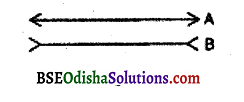
But actually both the lines are of the same length. Muller and Lyer, two psychologists, observed this kind of error in perception for the first time and hence called it Muller Lyer Illusion. In this visual illusion, both lines are of equal length. At the end of line ‘A’ two very short lines are joined just like an arrow and at the end of line ‘B’ two very short lines of the same size as line ‘A’ are joined like a feather.
These two are known as arrow-headed and feather-headed lines. Though both lines are of similar length the feather-headed line appears invariably longer than the arrow-headed line. It is a universal illusion as this error in perception takes place in every normal person due to the stimulus factor.
Even children old enough to express their nature of experience and some animals react in the same way as normal adults. Perception of the comer of buildings, and rooms is due to this type of geometrical illusion. Hering illusion, Zollner illusion, and Orbison illusion are some of the examples of geometrical and optical illusions universally found.
Hering Illusion:
It is named after Hering (1861). In the following figure, the two horizontal lines are parallel. The distance between 1 and 2 is the same, all the way across the figure. But they appear every one as unparallel. This is also called Fan’s illusion.
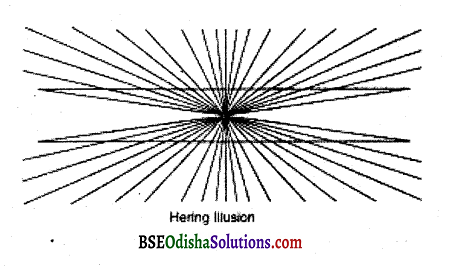
Zollner Illusion:
It is named after Zollner (1860). All these lines are drawn in a parallel way. But they are not perceived as parallel.

Height Width Illusion:
A tall hat is put in a short vase. The height and width of the hats are equal. But one looks taller than the other.
Ponzo Illusion:
It is also a geometrical illusion. Circles 1 and 2 are really of the same size. But circle 2 looks bigger than 1.
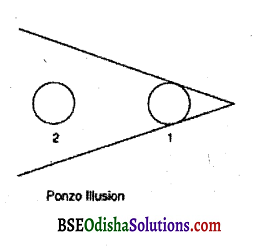
Jastrow Illusion:
The two crescents 1 and 2 are of the same size but 1 appears to be bigger than 2.
Question 5.
Define perceptual constancy. Perceptual Constancy
Answer:
The tendency of the percept to remain the same from moment to moment and from time to time refers to the constancy of perception. Even when we perceive an object under different conditions, size shape, and height, the perception of the stimulus does not change. It remains the same. Thus, in spite of the constant changes in the stimulus field, the stimulus situations that are familiar are easily recognized for what they are. Perceptual constancy includes the constancy of size, shape, distance, color brightness, etc.
Size Constancy:
The size of a stimulus varies with the change in distance in distance between the percept and the perceiver. A tree that is usually perceived at a distance of 5 feet will look very small when perceived from a distance of 30 feet. This is because the size of the retinal image becomes smaller and smaller as the distance of the object from the eye becomes larger and larger.
But in spite of this significant difference in the sense of impression, we perceive the tree to be of its usual size. Similarly, from whatever angle you perceive a square table, you will perceive it in its actual size. Martin did an experiment on size constancy. A series of 13 blocks were lined up from the observer varying in size from 30 mm to 90 mm.
The standard blocks, one at a time, were placed at varying distances from the observer, but always nearer to him than the comparison series. The technique again was to have the observer select the blocks that appeared equal in apparent size to the standard. Considerable constancy was indicated by the observer in the perception of the size of the blocks.
Colour Constancy:
When a black paper is brought from the dark comer of a room into direct sunlight by a window, the intensity of the sunlight being reflected from its surface is increased. The paper is still perceived as black, and the perception of the color of the paper does not change though the conditions against which it, is observed are radically changed.
When a blue paper is placed in yellow illumination of the optimum intensity and observed through a reduction screen it appears neutral grey. But when observed without the screen it appears as blue because in yellow constancy illumination is perceived as blue. Cramer has shown that well-known objects projected into an obviously colored screen, retain their object colors.
Shape Constancy:
We perceive a circle as a circle or a triangle as a triangle though it appears to be of different sizes from different angles. A circle may appear of an oval size from a particular angle, but we perceive it as a circle though referral images vary from angle to angle and position to position.
Brightness Constancy:
Under brightness constancy, a known object is always perceived as having the same color even if the conditions of illumination are quite different. Always the sense impression of the refer a very with the conditions of illumination that is dim, bright, average, etc.
![]()
Question 6.
Define illusions and illusions caused by stimulus factors and illusions of movement and moon illusion.
Answer:
Illusions- are wrong perceptions while perception is the correct interpretation of sensation, illusion is the wrong or mistaken interpretation of a sensory experience. In both perception and illusion, the sensory experience of a stimulus has real existence that is illusion always has an apparent external stimulus. In perception, the sensory conventional example of an illusion is taking a “coil or roope or rope for a snake in darkness”.
Illusions are misperceptions resulting from misinterpretation of information received by our sensory organs, illusions are experienced by all normal human beings, third, and animals. They are experienced through the stimulation of any of our senses. It is true that our perceptual process involves the organic and functional factors for the interpretation of a particular sensory experience.
Perceptual Process:
According to Morgon and King, “An illusion is not a trick or a misperception. It is a perception that does not agree with other more trustworthy perceptions. Illusions demonstrate that what we experience depends upon processes which go far beyond the sensory input.” Thus, a well-defined and very similar stimulus may lead to an illusion undo-certain circumstances, but not always.
As already discussed, our perceptual process involves the organic and functional factors for the interpretation of a particular sensory experience. In other words, we interpret a stimulus in the light of our past experience, organic needs, values, attitudes, motives, etc. If this interpretation is incorrect, we perceive the stimulus wrongly and commit mistakes in our perception.
Errors in perception are not very unusual and every individual is likely to commit errors in his perception in his day-to-day life. These errors mainly depend upon the physical and psychological conditions and circumstances under which the stimulus is interpreted. Illusions may be categorized under different heads on the basis of their causes.
Illusions due to organic and functional factors also occur due to defects in the sense organ of the perceiver and limitations in the receptors. Award-hearing persons or partially blind or colorblind persons may be liable to many illusions. Mental deficiency and emotional states also affect the accuracy of perception. Perception becomes distorted and is misinterpreted under highly disturbed and emotional states.
Illusion caused by Stimulus Factor:
Horizontal, vertical illusions occur due to the stimulus factor. Suppose we take two straight lines of 3 cm each. The first line we draw horizontally exactly from its middle point (1.5 cm):
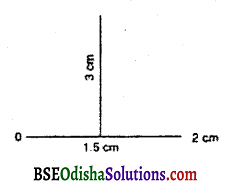
We draw another vertical line of 3 cm (the second line). Now observe both lines, the vertical line is observed longer than the horizontal line. This type of illusion is caused due to stimulus factors. Certain illusions also occur due to personal or functional factors like need, value, past experience such as observing the colored balloons as fruits.
Take another case. You have gone to the station to receive a friend. You call somebody else your friend from his back. This is an illusion due to expectations or mental set. A color-blind person cannot perceive the real color of a stimulus or a hard-hearing person may consider the sound coming from a truck as the sound coming from a scooter.
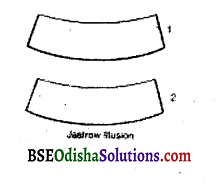
The illusion of Movement:
When an observer perceives a moving picture when actually the object is not moving it is called an illusion of Movement. This is also known as Phi-phenomenon named by Gestaltist Wertheimer. In Movies, T.V. screens, and electrical advertisements this illusion of movement is noticed.
What exactly mean? When a number of still pictures are projected one after another at a suitable rate, say for a fraction of a second, we see the picture moving though actually, they are static, still pictures. Take an example, you are traveling in a fast-moving train. You find the trees on both sides moving, though actually, they are static. This is also an illusion of movement.
Moon Illusion:
It is an example of the size constancy illusion. Hochberg writes, “It has been known as everybody the moon looks quite large when it is near the horizon than when it is overhead at its zenith even though the visual angle subtended by the moon remains constant”. Recent research on the Moon illusion has supported an ancient explanation.
The earliest explanation for this moon illusion has received some experimental support to argue that: “the sky at the horizon looks further away (due to the intervening fortress and thus the moon seems larger near the horizon.” (Kaufman and Rock). Thus, the distance is taken into account while judging the size of the object.

![]()
Question 7.
What is an illusion? Discuss briefly the various theories of optical illusion and Hallucination
Answer:
Although our perceptions are usually quite accurate, they are also subject to distortions called illusions. So these are wrong and incorrect perceptions. Here external stimulation is always present illusions are mistaken or wrong interpretations of sensory experiences. In the true sense, these are not perceptions.
Because in perception, the stimulation is correctly interpreted. Whereas, in illusions, the stimulation is wrongly interpreted. It is obvious that the experience depends upon the process. In short, illusions are misperceptions resulting from misinterpretation of information received by our sensory organs illusions are experienced by all normal human beings, birds, and animals.
They are experienced through the stimulation of any of our senses. It is true that our perception process involves the organic and functional factors for the interpretation of a particular sensory experience.
Theories of Optical Illusion:
Several theories have been developed to explain the causes of optical illusions, and they are discussed here briefly.
The Eye Movement Theory:
According to the eye movement theory, optical illusions sometimes occur if the eye movements are blocked due to the inward projection of other lines. This theory explains the Muller-Lyer Illusion.
The Perspective Theory:
It argues that everyone knows that distant objects appear smaller in size than nearer objects. The perceiver thus compensates for such learning even though they may be equal. Thus, he perceives the objects at a distance to be greater in size than the nearer ones.
The Confusion Theory:
The perceiver observes the percept as a whole, as one unit, and does not analyze it fully. It has been found that if the Muller-Lyer Illusion is analyzed by narrowing down over a range of vision, the illumination would be greatly reduced.
Good Figure Theory:
As a natural tendency, we eliminate the irregularities in a particular figure and fill up gaps to give it a complete meaning. We want to see the figure as a single, meaningful and compact unit. This leads to illusions. It has, therefore, been concluded that illusions like constancies are the natural products of certain factors like need, value, mental set and post experiences, etc. functioning in a given physical environment.
Hallucination:
It has been already discussed how the illusion is a normal affair. Most normal people sometimes or others experience the illusion. But hallucination which is also a type of perceptual error is experienced by mentally disturbed abnormal persons. It is also experienced by those who are under the influence of drugs.
Illusions always have an external stimulus. In hallucination, there is no real sensory stimulus or apparent objective external stimulus, but we perceive it as some object or figure and demonstrate experiencing a hallucination. For instance, when we visualize a ghost every night when there is none when we hear a huzzing sensation inside the stomach.
When there is no such sensation or when we experience severe pain when there is no pain sensation at all, we experience visual, auditory, and tactual hallucinations respectively. Hallucinations may be visual, auditory, olfactory, tactual, gustatory, etc. But usually visual and auditory hallucinations are more commonly experienced.
Hallucinations represent our inner conflicts, fears, anxieties, and mental imbalances. Particularly, in certain forms of insanity like Schizophrenia, hallucination forms a major symptom. Sometimes such patients hear the voice of God, and spirit and are found to actually talk with them in their imagination. Especially common are auditory hallucinations.
![]()
Question 8.
Critically examine the role of the organization in perception.
Answer:
Perceptual Organisation:
Very often we are confused. How does perception work? This question has long fascinated psychologists and philosophers, who have generated many theories to explain the key functions and operating principles of perception. Two prominent explanations are there:
- Experience-based influence and
- Gestalt Principles of Perception.
The experience-based inference was the dominant approach established by Hermann. Von Helm Holtz (1966). Helmholtz argues for the importance of experience in perception. According to his theory, an observer uses prior knowledge of the environment to make sense of the proximal stimulus. His theory proposes that we learn how to interpret sensations on the basis of our experience with the world.
But in the early 1.920, Gestalt psychologists maintained that psychological phenomena could be understood only when viewed as organized, structured wholes and not when broken down into primitive perceptual elements. The German word ‘Gestalt’ roughly means form, whole, or configuration. It challenged the views of structuralists and behaviorists by arguing that the whole is more than the sum of its parts.
Gestalt psychologists first study several aspects of perceptual organization systematically. Perceptual organization is the process by which we structure the input and create perceptual coherence. In other words, the perceptual organization puts sensory information together to give us the perception 6f coherence. Many of the organization processes we will discuss in this section were first described by Gestalt theorists who argued that perception depends on the laws of the organization or simple rules by which we perceive shapes and forms.
The organization of sensory data is the beginning of the perceptual process. We will have a confusing world if we do not put together and organize the information available to us through our millions of receptors. Max Wertheimer, Kohler, Koffka, and other Gestalt psychologists have studied and experimented on perceptual organization extensively.
They have discovered a number of principles relating to the organization of perception. According to these psychologists, an individual organizes a multitude of environmental stimuli into meaningful structures and forms. Always a person perceives patterns of stimuli rather than random collections of individual stimuli.
An individual integrates disconnected parts of sensory information into a meaningful structure, which ultimately results in the perception of a whole. So the perception of an object or event is something more than the sum total of its sensory input. To bring out a clear picture of the perceptual process, Gestalt psychologists have discovered a set of principles, which are popularly known as Gestalt laws of perceptional organization.
The Gestalt Laws of perceptual organization are based on three groups of principles:
- Laws of grouping
- Figure-ground relationship and
- The goodness of figures.
Laws of Grouping
Generally, the laws of grouping propose how certain elements in the perceptual field of an individual go together. The following are some important principles of grouping.
The Law of proximity (Nearness):
Very often, elements may be grouped according to their perceived closeness in time or space. In short, elements that appear together tend to be grouped together. Now see the figure below. Here eight lines are seen as four pairs of lines.

Here, a very pertinent question is – how does our visual system accomplish this perceptual grouping, the perception that sets of stimuli are together? The perception of stimuli as ‘grouped’ was first studied extensively by Gestalt psychologists. Max Wertheimer (1923). He presented subjects with arrays of simple geometric figures.
By varying a single factor and observing how it affected the way people perceived the structure of the array, he Was able to formulate a set of laws of grouping including proximity. According to Wertheimer, all else being equal, the nearest (most proximal) elements are grouped together.
The Law of Similarity:
Our tendency to perceive things are belonging together because they share common features reflects the law of similarity. This law proposes that with the proximity among elements being equal, perceptual elements that are similar in some respect tend to be grouped together.

In the above (Fig. 5.3), you see rows of triangles, squares, and circles rather than a column consisting of a triangle, a square, and a circle. In the figure, you observe triangles go with triangles, squares with squares, and circles with circles. Since there is a uniform distance between triangles, squares, and circles; therefore, the law of proximity does not occur.
The Law of Good Continuation:
This principle suggests that elements that appear to follow a particular direction, such as a straight line or a simple curve are readily perceived as forming a group. It is just a tendency to perceive stimuli as a part of a continuous pattern. In the figures below, you see a zigzag line with a curved line running through it, so that each line continues in the same direction it was going prior to the intersection.
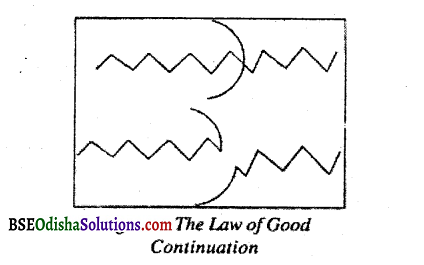
The Law of Closure:
We have a tendency to perceive stimuli as complete and balanced even when pieces are missing. Closure makes us see incomplete figures as complete and supplies the missing edge. beyond gaps and barriers. In other words, within limits, physically incomplete figures tend to be perceived as complete figures or as meaningful wholes.
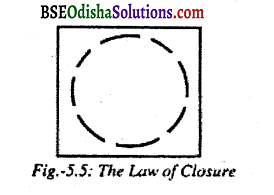
Here, grouping occurs in a way that favors the perception of the more enclosed or complete figure. Now from the figure above (See Fig. -5.5), the following curved line is not perceived as a curved line; rather, it is perceived as a circle. Here the curved line is not perfectly closed, but we see a circle because it is more tempting to perceive a complete figure than simply a curved line.
Attention and Perception:
The process of selecting a stimulus or a group of stimuli from among a large pool of stimuli is called attention. Attention is a complex process, combining a state of focused awareness with a readiness to respond. Attention influences both the stimuli an individual processes and the responses one is likely to make. Perception is a cognitive mechanism of sorting out, interpreting, analyzing, and integrating stimuli involving our sense organs and brain.
Perception is a receptive, selective, symbolic, and affective process. The process by which we structure the input and create perceptual coherence is called perceptual organization. Perception of an object or event is something more than the sum total of its sensory input. The perceptual organization puts sensory information together to give us the perception of coherence.
The Law of Common Fate:
According to this Gestalt principle, elements that are more in the same direction are perceived as together. Of course, this is a type of grouping on the basis of similarity but applied to moving objects. When we see a flock of birds moving in the same direction in the sky, it appears as groups or units. Now you can see how the law of common fate operates in the perceptual organization from the figure above (Fig -5.6).

The Law of pragnaz (Meaningfulness):
The principles of Gestalt grouping operate only when two or more elements, are simultaneously present in a visual field. According to Gestalists, the whole stimulus pattern somehow determines the organization of its own parts. In other words, the whole percept is different from the mere collection of its parts. Gestalt psychologists believe that all of these grouping laws are particular examples of a single general principle the Law of Pragnaz (Meaningfulness).
This principle reveals that the simplest organization requiring the least cognitive effort will always emerge. This law also proposes that we perceive the simplest organization which fits the stimulus pattern. The law of pragnaz is otherwise known as “the minimum principle of perception. ”

Again always we have a tendency to perceive figures as good, regular, and simple, with minimal cognitive effort. Therefore, this law is also known as the Law of Good Figure This law also emphasizes on the fact that we like to see regular and simple forms, rather than irregular forms.
![]()
Question 9.
Define the figure – Ground Relationship.
Answer:
Figure – Ground Relationship:
We tend to divide the world around us into two parts – a figure, which has a definite shape, and a location space, and ground, which has no shape, but seems to continue behind the figure and has no definite location. The figure-ground relationship helps clarify the distinction between sensation and perception.
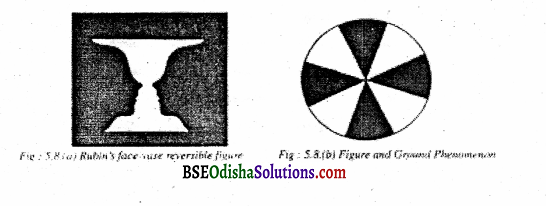
A figure is an object-like region in the forefront and the ground is the backdrop against which the figures stand out. The tendency to perceive a figure as being in front of the ground is very strong. When you perceive a region as a figure, boundaries between light and dark are interpreted as edges or contours belonging to the figure and the ground seems to extend and continue behind these edges.
When we see birds flying in the sky, birds are figures in the background of the sky. When you see the moon in the sky, the moon is the figure and the sky is the background. Similarly, the boat is the figure in the sea.

The following difference in the characteristics of figure and ground relating to any perceptual activity was observed by a Danish Psychologist Rubin( 1958). The figure has a definite shape, whereas the ground appears to have no shape. The figures have the quality of a thing, but the ground appears relatively formless.
The ground seems to continue behind the figure. But the figure seems to be present in front of the ground. The figure seems to be closer to the perceiver with a clear location in space. But the ground is farther away. It has no clear location in space. Always figure appears more impressive, dominant, and better structured. A figure has more associations with meaningful shapes than the ground.
Besides all these above differences, Coren (1969) revealed another difference between figure and ground. According to his observations, the figure is always brighter than the ground. There should be a stable perception of the figure. In short, a figure should be perceived as a figure on different occasions.
But when the figure-ground relationship is ambiguous or is possible for different types of interpretation, the perception tends to become unstable. In these occasions, the figure and ground reverse their positions frequently. Very often, the figure becomes the ground and the ground becomes like a figure simultaneously. Almost spontaneously these reversals occur. Now, look at figure 5.8(a). What do you perceive? A vase or two faces?
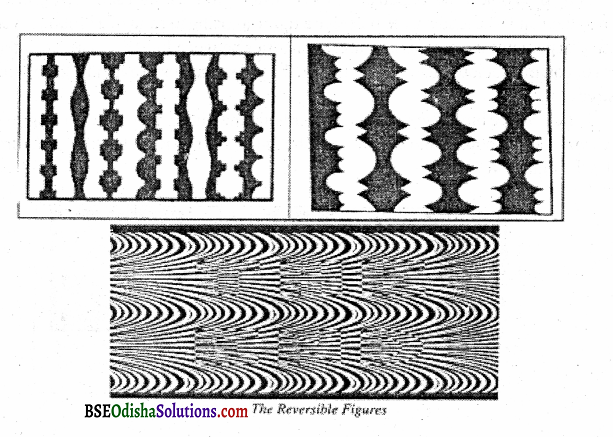
Perception of Movement:
Every day, we see the movement of different types of vehicles on the road, and birds and airplanes fly in the sky also, we see the movement of people around us. But how do we perceive this movement? Is there any difference between the perception of movement and the perception of static objects? In some instances, the objects do not move, but we perceive the movements of objects. How does this happen? Psychological, as well as physiological processes, are involved in the perception of movement.